By Pete Vack
Photos by Jonathan Sharp and Hugues Vanhoolandt
On October 25, 1964, as he won the Formula One World Championship driving for Ferrari, John Surtees achieved what no man before or since has accomplished, becoming a world champion on both two wheels and four. Catching up with the indestructible 67-year-old champion at the Amelia Island Concours in 2001, we were granted an exclusive interview with the Champion and learned firsthand the perils and pleasures encountered while racing for both MV Agusta and Ferrari. This interviewed originally appeared in Forza magazine in 2001, and we reproduce the full text below for the first time in VeloceToday. This is Part 2.
By the end of the year, Ferrari was knocking at the door of John Surtees. Bravely, he turned Mr. Ferrari down, politely, of course, and probably the only driver aside from Stirling Moss to do so. He was working on a new Lola and found sponsorship with Bowmaker for the 1962 season, and knew he wanted to go to Ferrari feeling 100% sure of himself and his abilities. In late 1962, he was again approached by Ferrari. Surtees recalled this time, relating it to his motorcycle years. “In terms of satisfaction, the motorcycle career was better, because I made less mistakes off the track. I knew all the people. With car racing, I didn’t know a soul, had never really seen a race car. I found out the hard way who you could trust and who you couldn’t.”
He had been “led up the garden path” by the English manufacturers. The Coopers he drove in 1961 weren’t works models but standard models, despite promises to the contrary. The deal with Lotus blew up. Bowmaker Lola were suddenly not important enough to get a new supply of the Climax V-8s. “When Ferrari came along the first time I knew I wasn’t ready, but when they asked again, I bolted to safety.” He had spent a lot of time with the Italians, and figured he could deal with them on equal terms. However, politics and intrigue followed him around the continent.
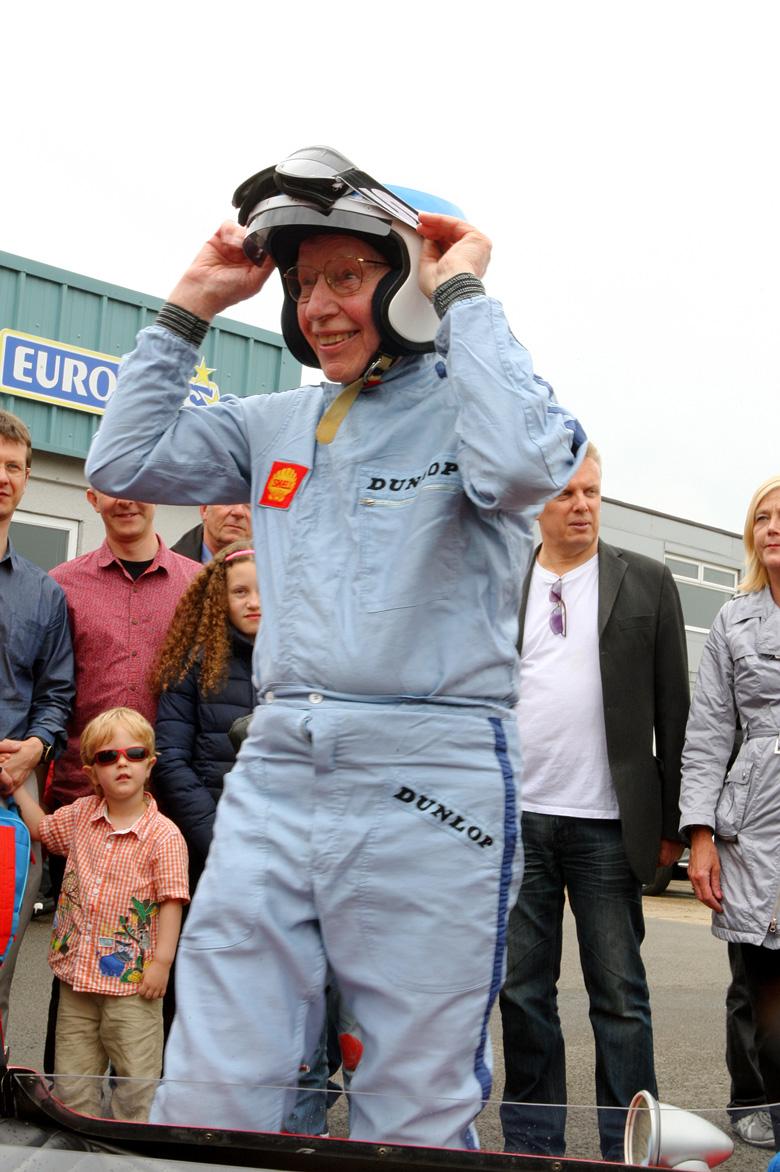
Getting ready to depart for several spirited laps around John’s home town of Edenbridge in Kent in 2014. The event was the celebration of the 50th anniversary of his Formula One world championship. Jonathan Sharp photo.
He can’t say he wasn’t warned. At Monza 1962, Juan Manuel Fangio heard Surtees was about to join Ferrari. Fangio, who had himself said “Basta” at the end of the 1956 season, pulled him to one side and said in Italian, “Giovanni, stare attento. Maranello molte pericoloso.” * Late in 1961, Laura Ferrari had created havoc in the palace, causing the revolt of key drivers and engineers. At the end of 1962, Phil Hill went to join the ousted Carlo Chiti at ATS. Surtees, instead of safely bolting to Ferrari, was stepping into a factory still in turmoil. The 1962 F1 season had been a total failure in the light of Graham Hill’s BRM and the Lotus-Cosworth V8. The new engineers and drivers were expected to turn things around.
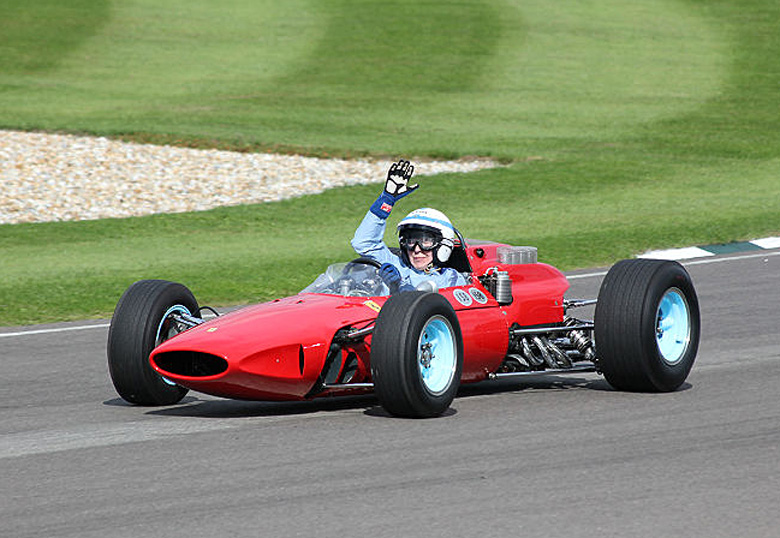
Surtees on the track at the Goodwood Revival with the Ferrari 158 with which he won the F1 title in 1964. Surtees encouraged Ferrari to look outside of Maranello for ideas and new technology. Hugues Vanhoolandt, Goodwood 2010.
Surtees vowed to do his part, working hard to sort out his new 250P for his maiden race for Ferrari at Sebring on March 23rd. Ever the perfectionist, he spent a great deal of time in Italy setting up the cockpit to his liking and tending to a myriad of details to improve the car. When it arrived at Sebring, however, he found it had been assigned to Mairesse and Vacarella. Peeved but determined, he decided that he and co-driver Scarfiotti would go for the win despite the change. He made sure he had bedded in new brake pads during practice but discovered that a new unbedded set had been installed when he went right down the escape road. Exhaust fumes nearly overwhelmed both drivers, as the rear engine cover was not a good fit. He won the race anyway, sick from the fumes, but happy. As soon as the team returned to Italy, team manager Eugenio Dragoni told the press (incorrectly) that the lap charts were wrong and Surtees didn’t in fact win the race! Surtees almost walked out on Ferrari after his first race. He now knew where the trouble spots were and they weren’t something that could be fixed with spanners. “I tried to work with Dragoni, because he was a part of our team”, recalled Surtees. But the relationship never did develop in a positive sense.
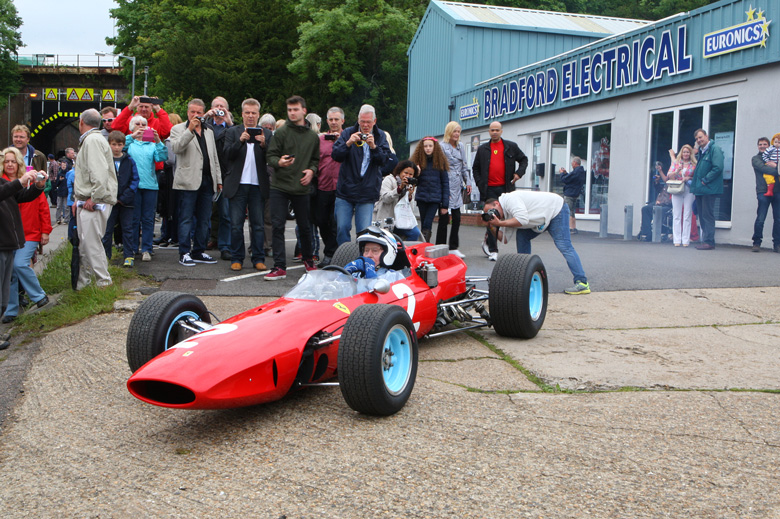
The 50th Anniversary of the 1964 World Championship was held in Edenbridge, Kent in front of the old Team Surtees race shop, which today is an electrical appliance retailer.Jonathan Sharp photo.
After Sebring, he was eager to test and develop the new 156 F1 car, now with direct fuel injection. To his dismay, he found that proper development was delayed by Ferrari’s sports car program, which was on full throttle. “It was a very critical time for Ferrari. Much of what he did was because he had to keep a lot of balls in the air. It wasn’t just a question of people resources, it was a question of money,” he said. Ferrari not only had to produce GT cars, but get a team ready for Le Mans, and make sure he received support dollars and entry fees. “After I started my own team I then learned why Ferrari did things, that at the time seemed quite inconceivable.” Surtees managed to win the German Grand Prix at the Nurburgring, place second at the British Grand Prix and 3rd at Belgium with the 156. In sportscars, he won again at the Nurburgring with Mairesse.
At the end of 1964, only four years after Surtees began actively competing on four wheels, he became the Formula One World Champion. He drove the 158 Ferrari to wins at the German and Italian GPs, backed by solid placings in Holland, Britain, the U.S. and Mexico. “One of the reasons I went to Ferrari is that I thought at least it wouldn’t loose wheels or suspensions,” he said. “Strangely enough, I had the steering break on the Ferrari during the Austrian GP, which I was leading at the time. Had I won, it would have won the Championship much more comfortable.” His championship year was frustrating, filled with mechanical failures and lack of development that his account, could have been avoided.
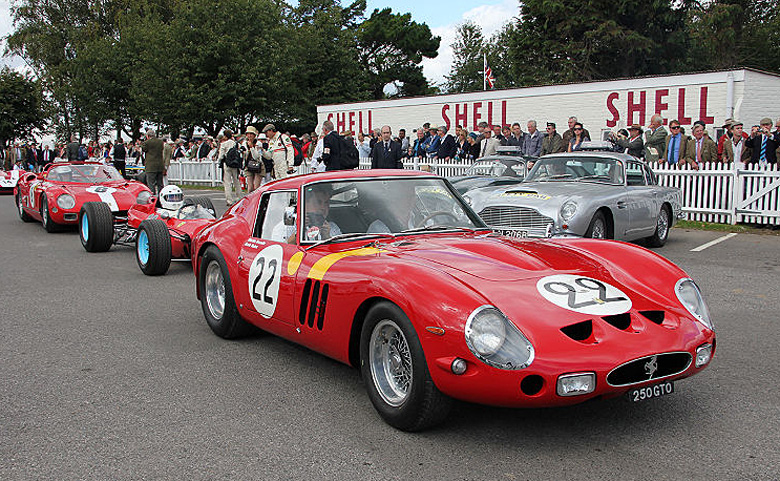
John led the ’62 Goodwood TT in a GTO similar to this one, which is owned by Nick Mason. Aston Martin driven by Jim Clark spun in front of Surtees, ending the race for Surtees. Hugues Vanhoolandt, Goodwood 2010.
At Goodwood, Surtees’ GTO spun off the track and the severe impact left him with a seriously bruised neck. Participation in the sports car events yielded no victories with the 275LM and 330P. He became World Champion, but there was much lacking when so many opportunities had been lost.
Not earning much at Ferrari and wanting to race in other series, Surtees approached Ferrari and asked him if he could race the Lola Can Am car. Ferrari wasn’t participating, so his request was granted. By doing so, Surtees realized that one of the problems with Ferrari was isolation from the rest of the racing community, which now centered in Great Britain. “I was trying to get Ferrari to understand that the world was larger than their own little circle in Maranello. In England, Lotus, Lola, Cooper and BRM all learned from each other. This tended to isolate the Italians. I made a point of trying to learn from others. When I spoke to Ferrari about running the Lola, I told him, look not only are you getting isolated but I’m getting isolated here, surrounded by only Maranello technology.” Ironically, establishing Team Surtees and racing the Lola would result in the most serious accident of his career, and precipitate the end of Surtees’ Italian Odyssey.
Fresh from a win at St. Jovite with the Lola T70 Can Am, Surtees went on to practice for the event at Mosport on September 24th. “I didn’t know it had a new upright, mistakenly fitted to the car before it was properly tested. The core had moved and the wall thickness was too thin. I happened to shatter at Mosport. Just one of those things.” The Lola hit a barrier, and went over several times before landing on him. His pelvis was broken and kidneys punctured. He recovered quickly, and when he went to Maranello in January of 1966, still using a cane, “everyone seemed to have tears in their eyes”. All but Dragoni, who saw an opportunity for change. Dragoni, who desperately wanted an Italian World Champion, was in the full Bandini mode, and getting support from Mike Parks, who wanted a Formula One seat. Not only would he have to endure a painful recovery period, but test a new round of cars and deal with the darkening political atmosphere.
Nevertheless, Surtees looked forward to the new season, with the new, more powerful 3 Liter Formula One cars. Determined to show his commitment, after 10 years of running back and forth to England, he accepted an offer from Ferrari to live in a flat in Modena, just up the road from Lina Lardi, Ferrari’s mistress. Italy finally would become home. Ferrari also promised he would be given more team responsibilities. He settled in, but not for long.
He won his first race after the accident at Monza with a P3, but it resulted in a disagreement with Mike Parks. There was a conspiracy, and as Surtees recalled, “Parks resented the fact that I did all the testing, and Dragoni in turn resented the fact that I had the ear of the old man.” While most acknowledged that Surtees had returned to form after the accident, Dragoni insisted upon casting doubts in regards to his ability, by telling the press that Surtees was not looking fit and was very pale.
For the new Formula Ferrari had created the 312, a rather large car with a V-12. Surtees knew that the smaller 246 V-6 engined car developed for the Tasman Series would perform better, particularly at Monaco. His requests were firmly denied by Dragoni, and the race at Monaco was lost due to transmission failure, just as Surtees had predicted. At Spa, where he won brilliantly in wet conditions, Dragoni criticized his driving for being too slow. Finally at LeMans, Dragoni allowed Scarfiotti to start the race, despite the fact that Surtees was much faster. Surtees left the track, as angry as he’d ever been, and went to Maranello to meet with the old man. “Basta,” he said.
Surtees recalled that moment 35 years ago as if he had just walked through the famous Ferrari gates for the last time. He’s had a long time to think about it, but speaks not. “Some things which were said at the time I left Ferrari I will never repeat, as we agreed and Ferrari never repeated these things. Certain other aspects came into play—not to do with me, but with the consequences, if I should stay, if I should leave.” It was decided Surtees should leave the team, but the feelings between Ferrari and Surtees were never bitter.
In Italy recently, a dinner was given in Surtees’ honor by Ferrari, Surtees said “At this event, Mr. Ferrari’s secretary, Dr. Gozzi, remarked that what happened at that time was not good for Ferrari, and that it would never have happened if Mauro Forghieri had stood up and been counted on to tell the truth.” As Surtees sees it, Forghieri was the one person who could have eliminated the collusion, which took place between Parks and Dragoni. “I always got along well with Forghieri, but he chose to sit back, partly, I think, because he was slightly offended as I was bringing in outside help and influences.”
Years later, the late Denis Jenkinson criticized Surtees, writing that “..had he not tried to become involved in the technical side of racing and instead concentrated solely on driving, he undoubtedly would have been a far better driver than he was.” Surtees responded carefully. “Denis did not know or understand my true approach. If he had cared to look at the situation, there wasn’t a team I was on which didn’t need some involvement. And as I left all were in a better state than when I arrived. But I didn’t try and design the car, just relate what was happening and give a clear message. Perhaps he was right and I shouldn’t have shown so much interest. Today, Denis might say the same thing about Schumacher. I don’t think my approach to input in those years was any different than what Shumacher does today.”
Sitting back and thinking, Surtees made a further observation about Enzo Ferrari. “I was very fond of him in my own way, as I believe he was of me. But, I see strong parallels between Enzo Ferrari and Soichiro Honda, with whom I later worked. They both had outlived their worth to the companies they created. The very methods and attitudes which were forged in the conflict of creating their names were no longer appropriate or acceptable.” Ferrari, and Honda, with their emphasis on conflict was the old feudal way of thinking. If there wasn’t a conflict Ferrari would create one. “For example, one year, within our team, we had a journalist awarded a prize. But he was responsible for creating more adverse comment by writing that I had complained about Forghieri or that Forghieri had complained about me, or that I’d fallen out with Bandini. He was actually paid by Ferrari to write these articles!”
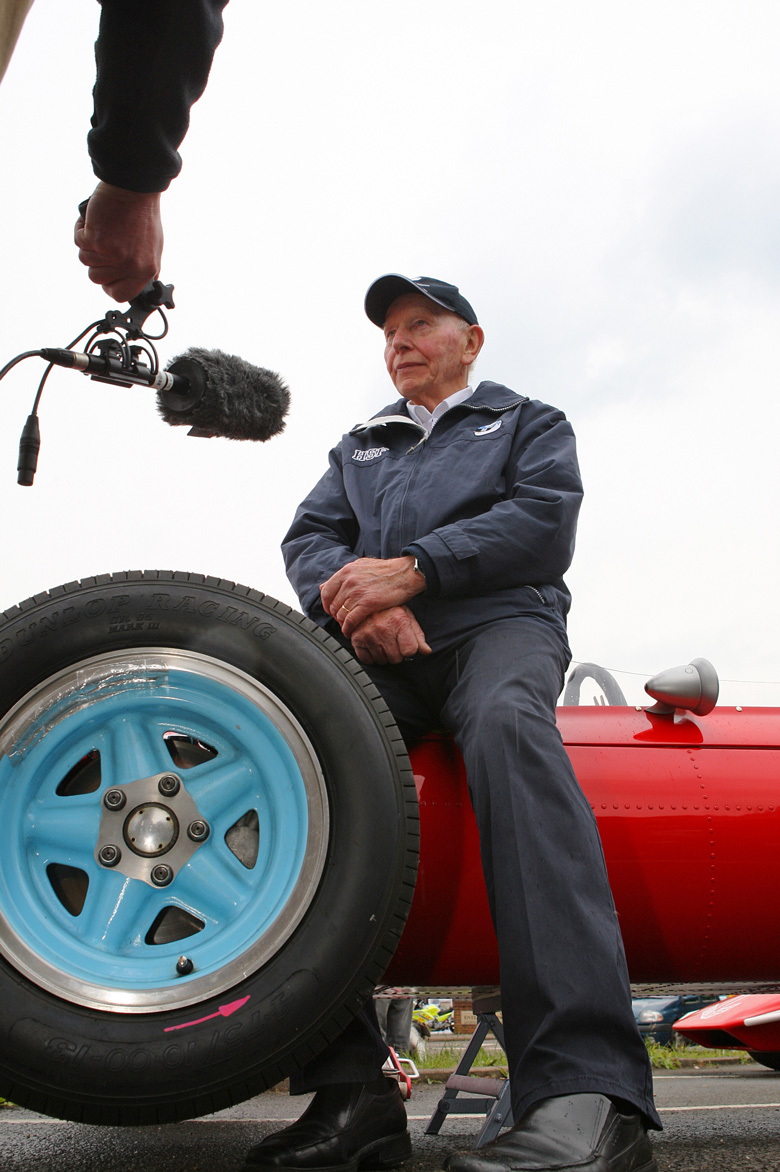
Taken during one of many interviews that John gave during his Golden Jubilee celebration outside of the old race shop. Jonathan Sharp photo.
When Surtees walked out, Ferrari lost the chance at another championship; it would not win another until 1975. Bandini was good, but not as good as necessary and died at Monte Carlo in 1967. Parks, severely injured the same year at Spa, never worked out as a Formula One driver. Dragoni, though he lived until 1974, never saw another Italian World Champion, and indeed, the Italian dream remains unfulfilled. Surtees returned to England, went on about life and racing, and added another championship to his list when he won the Can Am championship with the Lola in 1966. After driving for Honda, BRM, McLaren and his own Surtees TS Formula One machines, he retired from competition at the end of 1972.
Today, he keep busy with his wife Jane and their three children. His son Henry, now 10, has been Karting for about a year. “I told him I’d support him but the drive has to come from him, I’m not going to be the driving force. I’ve seen this happen all too often when I’ve been to these events. The fathers are probably frustrated would-be race drivers.” Surtees is finally in his parent’s shoes. “Karting can be quite aggressive and competitive, and frightening in some ways. I can imagine that I get the same emotions now that my mother and father must have had when I was 15 and started racing. It’s now my turn to go through it.”
*Johnny, pay attention. Maranello is very dangerous.
PS.
Sadly, John’s son Henry died in a freak accident in 2009. John Surtees established the Henry Surtees Foundation, and continued to be a great ambassador for the sport.
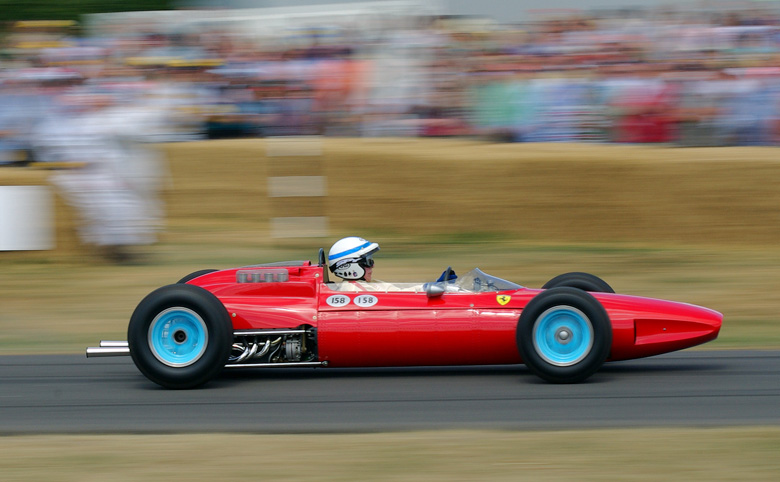
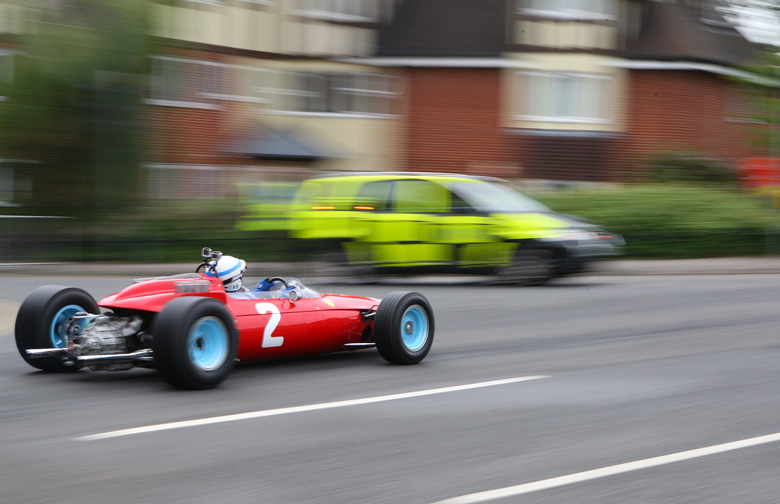
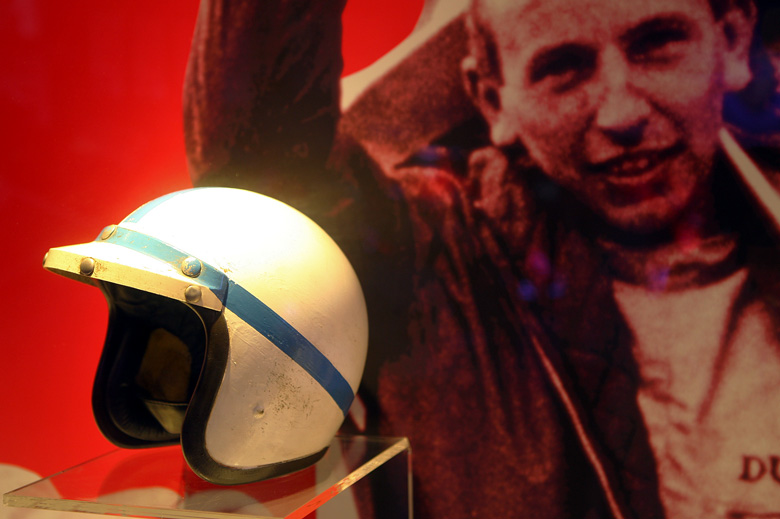
Great diver and man !!